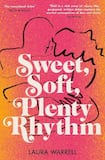
Sweet, Soft, Plenty Rhythm is jazz masquerading as a novel. Some will love it while others (people who like unfussy sentences or pop music, say) will grow irritated within the first few pages. The style has an almost lulling effect, as though one were lilting gently on the swell of each paragraph. In some hands this would be grating but, luckily, Warrell pulls it off.
The novel is told from numerous perspectives seemingly structured to interact like instruments in a band. Each voice is given its own chapter, some repeating, some not. They all have their own distinctive cadences, reflecting the character’s mood, sanity, age or, occasionally, how much they’ve had to drink. It’s clear much time has been spent on achieving this effect with, I imagine, meticulous care given to every consonant. Although this comes dangerously close to feeling overwritten (Warrell’s position as a creative writing teacher won’t come as a surprise), on the whole the effect is sensuously pleasurable.
Yet it’s not all sound and rhythm. Certain characters, like Koko, are exceptionally well drawn (even if others, like Circus Palmer, a womanising jazz musician, never quite develop beyond caricature). Warrell’s portrayal of Koko’s adolescent sexuality is beautifully done (Warrell is brilliant at writing female desire – rarely have I read the physical sensations of sex transmuted into language so deftly), and her experience of being mixed-race is also movingly depicted. She is at once disdainful of and intrigued by her own changing body, while simultaneously hyper-aware of her difference to those around her, most notably her mother’s family, who are white, blonde and thin.
Warrell’s writing conveys a deep understanding of the tribulations that can come with heritage, alongside those of early womanhood. Reading Koko’s part, I wondered whether any female gets through puberty without being made to feel they’re “too much”. Possibly not.
‘Forget about glamour’: Jonathan Anderson offers advice to would-be fashion designers as he receives TCD honour
Death of Pope Francis: Derek Mooney leads RTÉ’s coverage to intermittently jaw-dropping effect
Chob Thai restaurant, Clontarf: The most memorable thing here is the bill
Careless People: The controversial book is shocking and reveals Facebook is far worse than we could have suspected
The novel’s greatest strength is, perhaps, Warrell’s nimble handling of weighty topics such as these. Although it touches on many of the serious issues of our day (feminism, sex, race, mental health), never does it feel didactic or effortful. Instead, it is filled with pathos and humour. Being jazz, it even contains some moments of real, melodious grace.













